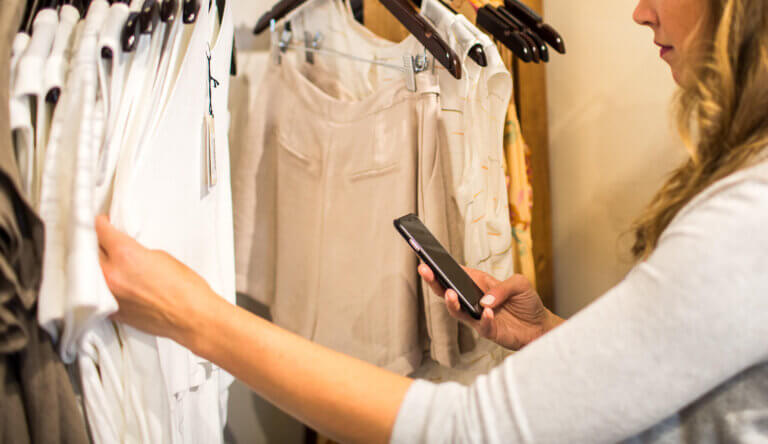
Digital Retail Marketing: Making Online & Offline Work Together
British retailer John Lewis uses beacons at its U.K. department stores where they sell everything from iPads to suitcases. When a customer with the company’s app is within 70 meters of a store, the beacon sends an alert asking if the shopper is coming to pick up a purchase. If yes, a staffer prepares it before the customer reaches the counter.
In a recent webinar (now available on-demand), Brendan Witcher, principal analyst from Forrester Research, cited this example to illustrate the critical importance of fusing digital and physical retail customer experiences into an omnichannel approach.
An omnichannel approach involves “the coordination of traditional channels – marketing, selling, and fulfillment – plus the supporting systems, to create a seamless and consistent customer experience across the enterprise.”
While some retailers still regard digital channels to be a marketing tool to get customers into a physical store, Witcher says retailers need to see the future and get on board.
These statistics illustrate how important it is for retailers to get omnichannel right:
-
Of $3.4 trillion devoted to retail sales every year, just $400 billion is spent online. The rest still takes place in physical stores.
-
The amount spent by customers who go online to find products and the right vendors but then shop in physical stores totals $1.37 trillion per year, and the number of people with this shopping approach is growing.
-
40% of consumers now buy online and pick up orders in stores. Sixteen of the top 20 US retailers enable their customers to do that.
-
By 2020, Forrester expects mobile phone and tablet commerce to make up more than 48% of online retail sales.
Case in Point for Omnichannel Success: Sephora
Sephora, said Witcher, is one of the brands that has “reached mastery” in digitizing its business strategy — rather than just including digital.
For example, the cosmetics retailer offers in-store “digital touchpoints” such as their “Fragrance IQ” kiosk, as well as mobile experiences that provide ways for customers to interact with Sephora more deeply at their physical locations.
As a result of this approach, he says, other marketing messages, like emails and push notifications leverage more customer data, and therefore can be more personalized and relevant.
How Mobile Fits Into the Omnichannel Picture for Retailers
Cohesion between online and offline channels eludes some retailers because they can’t see the return on investment, Witcher said. It’s important to find ways to expose and track this data.
Push notifications can help make the case, said Emily Buckman with Urban Airship’s strategic services team. With push notifications, it’s possible to match up push notifications sends with the conversions they influence or drive directly.
For example, during a pre-holiday Cyber Weekend sale, one U.K. retailer sent “abandoned basket” messages to motivate completion of tentative purchases. They found that 39% of sales were influenced by a push message or other app-generated reminders. Those sales in turn made up 59% of the total revenue that went through the retailer’s app that weekend.
Mobile wallet is also part of the mobile ecosystem retailers should pay attention to, says Buckman. Customer appetite for using mobile wallet is growing. Urban Airship survey indicating that 54% of consumers have a mobile wallet and hope to use it more.
Retailers can create mobile wallet passes to send customers a digital coupon — and send them notifications straight from the pass to alert them to updates, new offers, expiration dates and more.
Loyalty programs can also benefit from being incorporated into mobile wallets. With a digital loyalty program card living on a customer's phone, it’s virtually impossible to forget — and much more likely to get used. Mobile wallet loyalty cards can also show real-time updates, including points and rewards earned, in real time.
Surveyed Retailers Say Omnichannel is “Critical,” But Physical/Digital Alignment is Elusive
Nearly all senior marketing leaders who responded to a survey last year see omnichannel marketing as critical or important, Adweek reports. But 48% say alignment between local and online campaigns is “hit-or-miss,” and just 30% say campaigns were aligned and executed well across everyone involved.
Customers want an online-offline balance because they care about “experiences” that are best delivered by a hybrid approach to digital retail marketing, Witcher argues.
They want the John Lewis clerk to have an order ready for pick-up at the moment of arrival.
Super-fine data crunching ultimately powers stores’ ability to treat customers as a “segment of one,” he says, by extending generalized understandings of consumer behavior to personal ones.
“If I always buy a shirt and a pair of pants, it doesn't matter if every nine out of 10 customers that you serve always buy two shirts together,” Witcher says. “If I buy a shirt, show me some pants.”
Embracing digital marketing is important in the retail sector, but it’s not an end in itself. Understanding customers and their needs is critical whether the interaction is online, offline, or a mix of the two.
Watch the full webinar, 3 Imperatives Retailers Can’t Afford to Ignore, on demand anytime.
For more mobile and digital marketing insights for retailers, check out all of our retail-focused blog posts and subscribe to the blog so you’ll never miss a post!
Subscribe for updates
If the form doesn't render correctly, kindly disable the ad blocker on your browser and refresh the page.
Related Posts


Boost Holiday Retail Sales: A Year-Round Planning Checklist for Mobile Marketers

